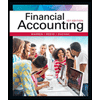
Concept explainers
A company’s
- a. $5,354
- b. $328
- c. $5,026
- d. $4,698
- e. $34,338
Identify the amount of bad debt expense that would be recorded at December 31.
Answer to Problem 1MCQ
The bad debt expense is recorded at December 31 is $4,698.
Explanation of Solution
Accounts receivable
Accounts receivable refers to the amounts to be received within a short period from customers upon the sale of goods and services on account. In other words, accounts receivable are amounts customers owe to the business. Accounts receivable is an asset of a business.
Bad debt expense:
Bad debt expense is an expense account. The amounts of loss incurred from extending credit to the customers are recorded as bad debt expense. In other words, the estimated uncollectible accounts receivable are known as bad debt expense.
Percentage-of-receivables basis:
It is a method of estimating the bad debts (loss on extending credit), by multiplying the expected percentage of uncollectible with the total amount of receivables for a specific period. Under this method, the estimated bad debts would be treated as a target allowance balance.
Identify the amount of bad debt expense that would be recorded at December 31.
Normal balance of allowance for doubtful accounts (contra asset account) is credit balance. It is given that the Company’s unadjusted balance in Allowance for doubtful accounts is a credit of $328. Determined estimated uncollectible receivable is $5,026. Hence, to bring the allowance for doubtful account balance from a credit of $328 to credit of $5,026, bad debt expense must be recognized and increased by $4,698, and allowance for doubtful accounts must be increased by $4,698.
Therefore, the correct answer is option d. $4,698.
Want to see more full solutions like this?
Chapter 9 Solutions
Principles of Financial Accounting.
- What is the main purpose of a cash flow statement?a) To report profits and lossesb) To show changes in equityc) To report cash inflows and outflowsd) To show the company's assetsarrow_forwardI need help with this general accounting question using the proper accounting approach.arrow_forwardI am looking for a step-by-step explanation of this financial accounting problem with correct standards.arrow_forward
- Which method of inventory valuation assumes that the earliest goods purchased are sold first?a) FIFOb) LIFOc) Weighted Averaged) Specific Identificationneed help!arrow_forwardPlease provide the solution to this general accounting question using proper accounting principles.arrow_forwardWhich method of inventory valuation assumes that the earliest goods purchased are sold first?a) FIFOb) LIFOc) Weighted Averaged) Specific Identificationdont use aiarrow_forward
- Please provide the answer to this financial accounting question using the right approach.arrow_forwardIdentify and explain three itemized deductions that are available to taxpayers. Are there any that you would add and if so, which ones?arrow_forwardDepreciation is classified as a(n):a) Assetb) Expensec) Liabilityd) Revenueexplain.arrow_forward
- Principles of Accounting Volume 1AccountingISBN:9781947172685Author:OpenStaxPublisher:OpenStax College
 College Accounting, Chapters 1-27AccountingISBN:9781337794756Author:HEINTZ, James A.Publisher:Cengage Learning,
College Accounting, Chapters 1-27AccountingISBN:9781337794756Author:HEINTZ, James A.Publisher:Cengage Learning, Cornerstones of Financial AccountingAccountingISBN:9781337690881Author:Jay Rich, Jeff JonesPublisher:Cengage Learning
Cornerstones of Financial AccountingAccountingISBN:9781337690881Author:Jay Rich, Jeff JonesPublisher:Cengage Learning  Intermediate Accounting: Reporting And AnalysisAccountingISBN:9781337788281Author:James M. Wahlen, Jefferson P. Jones, Donald PagachPublisher:Cengage Learning
Intermediate Accounting: Reporting And AnalysisAccountingISBN:9781337788281Author:James M. Wahlen, Jefferson P. Jones, Donald PagachPublisher:Cengage Learning Managerial Accounting: The Cornerstone of Busines...AccountingISBN:9781337115773Author:Maryanne M. Mowen, Don R. Hansen, Dan L. HeitgerPublisher:Cengage Learning
Managerial Accounting: The Cornerstone of Busines...AccountingISBN:9781337115773Author:Maryanne M. Mowen, Don R. Hansen, Dan L. HeitgerPublisher:Cengage Learning Financial AccountingAccountingISBN:9781337272124Author:Carl Warren, James M. Reeve, Jonathan DuchacPublisher:Cengage Learning
Financial AccountingAccountingISBN:9781337272124Author:Carl Warren, James M. Reeve, Jonathan DuchacPublisher:Cengage Learning





